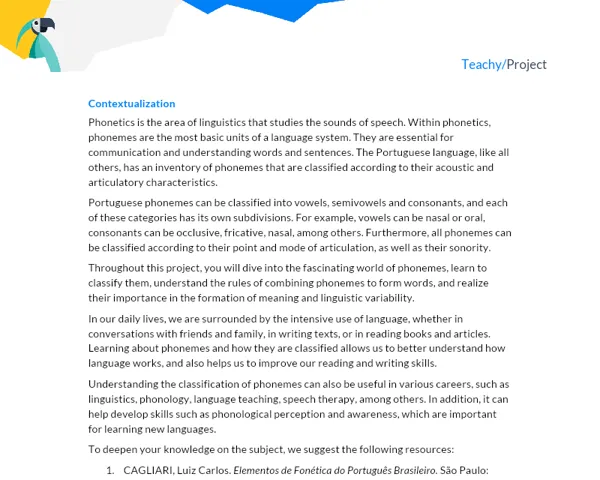Contextualization
In this innovative project, we will explore two important literary genres: the tale and the chronicle. Both are characterized by their brevity and conciseness in the exposition of stories or reflections. They differ, however, in the tendency of the tale to bring complete and closed narratives, usually fictional, and the chronicle to address everyday life in a freer way, often making use of argumentative dialogue.
Argumentative dialogue, in turn, is a literary resource widely used to express different perspectives on the same theme or event. Through it, authors can give voice to different characters, creating a dynamic and multifaceted scenario capable of stimulating the reader's critical reflection.
In the theoretical field, we will make a detailed analysis of how these genres use argumentative dialogue to structure their narratives and how such strategies impact the reader. For this, we will study some works by recognized authors and discuss their writing techniques.
The study of tales and chronicles and the use of argumentative dialogue in their structures are fundamental for the development of textual comprehension and critical thinking skills, essential abilities in contemporary times. We live in a world where we are constantly exposed to different narratives and arguments. Understanding how they are constructed and employed is a valuable tool for active and critical participation in society.
Furthermore, mastering these genres and techniques can be a great way to spark interest in writing. After all, who has never dreamed of writing their own stories, whether fictional or reflections on everyday life?
Practical Activity
Activity Title: Tales, Chronicles, and Argumentative Dialogues in Action!
Project Objective
This project aims to provide an immersive and practical experience in the art of writing tales and chronicles using argumentative dialogues. Students will have the opportunity to write their own stories, using the studied techniques and concepts.
Detailed Project Description
Students will be divided into groups of 3 to 5 people, where each group must create a tale and a chronicle. Both must feature argumentative dialogues and bring a central theme in common, discussed and chosen by the group members. The theme should allow for critical analysis and the presentation of different points of view.
The tales and chronicles should preferably bring characters, scenarios, and themes that are familiar to the students, so they can explore their argumentation skills and critical observation of everyday life.
The project should be developed over a month, with a minimum of five hours of work per student. Students must organize themselves to divide tasks and manage time in the best possible way, ensuring that all members actively participate in the creative process.
Required Materials
- Notebook or paper for drafting
- Pen or pencil
- Computer with internet access (for research and typing the final text)
- Books, websites, and videos suggested in the contextualization
Detailed Step-by-Step
- Formation of groups and initial discussion on possible themes for the stories.
- Individual research on the chosen theme, tales and chronicles for inspiration, and techniques for writing argumentative dialogues (using the suggested resources).
- Sharing of research and collective discussion to define the characters, scenarios, and main points of the stories.
- Division of tasks among group members (who will be responsible for writing each part, who will do the revision, etc).
- Individual elaboration of the assigned parts.
- Meeting to combine the parts, collective revision, and improvement of the text.
- Finalization of the text and final revision.
- Writing the project report.
Project Deliverables
At the end of the project, each group must deliver:
- The written tale and chronicle, already revised and finalized.
- A report on the project, containing:
- Introduction: Contextualization of the theme, its relevance and real-world application, and the project's objective.
- Development: Explanation of the central themes of the project, the activity carried out in detail, the methodology used, and the presentation and discussion of the results obtained. Students must explain their choices for the characters, setting, and theme of the stories, how they used argumentative dialogue, and what challenges and solutions were found in the process.
- Conclusions: Recap of the main points, lessons learned, and conclusions about the project. Students must reflect on the importance of argumentative dialogue in stories, how this resource impacted the narrative, and the reception of the stories by others.
- Bibliography: Indication of the sources used to work on the project, such as books, websites, and videos.



